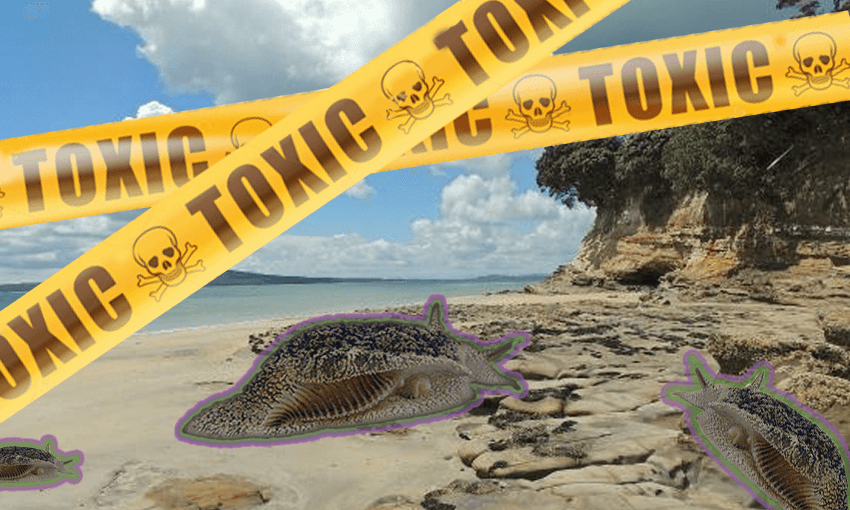Auckland Council is warning its citizens to keep an eye on children and dogs at the beach this summer as washed-up toxic grey side-gilled sea slugs pose a grave threat.
What’s this sea slug I’m hearing about?
The grey side-gilled sea slug (Pleurobranchaea maculata) may be native to our beautiful country, but it could be a toxic blight on Tāmaki Makaurau’s beaches.
In 2009 several Auckland dogs died after eating the slugs which contain tetrodotoxin, usually found in puffer fish.
They’re not common, and there have been no confirmed kills since the dog spree 11 years ago. In 2018 a slug was suspected to be behind the death of a Thames Coast chihuahua, but this was never proven.
Today Auckland Council put out a release asking people to remain vigilant, as the summer months could bring the slugs out of the depths.
What does the slug look like?
It’s grey, slimy, and up to 10cm long. The largest ones are found in the South Island. They’re called the “side-gilled slug” because they have gills along their sides, which are easy to spot if you’re close enough but you probably shouldn’t get that close.
What is tetrodotoxin?
It’s most famously associated with pufferfish, which contain enough tetrodotoxin to kill 30 adult humans. However, they’re not the only animal that contains the toxin: it’s also been found in crabs, newts, ribbon worms, and blue-ringed octopuses.
University of Auckland marine biologist Professor Mary Sewell said the slugs, like other animals, probably accumulated the toxin through their diet.
“The toxin appears to be produced by micro-organisms such as bacteria and perhaps microalgae (evidence not definitive), and as the highest concentrations are in the digestive glands of gastropods like Pleurobranchia, it is assumed that accumulation of the toxin is from the diet.”
However, nothing is known for certain.
Where are the slugs?
The slug can be found all over New Zealand, but do not appear to have caused any deaths outside Auckland. NIWA says it’s still unknown whether all members of this species are toxic, or if the toxicity is limited to North Shore and Coromandel slugs.
“There has been some social media activity around dogs becoming unwell after visits to Orewa and Takapuna beaches,” said Auckland Council spokesperson Mervyn Chetty. It might seem the North Shore is at greater risk, but Auckland Council urges vigilance at all Auckland beaches.
Are the sea slugs a plague sent by God?
No, it’s just summer. In warmer weather, the slugs can lose their grip on shallow tidal rocks and wash up on the beach. Two slugs collected in 1923 also tested positive for tetrodotoxin, so this is nothing new.
What do I do if my dog eats the slug?
If you suspect your dog has eaten or even just licked the slug, contact your vet immediately. Symptoms like panting hard, coughing, and paralysis can occur before death.
What will happen if I eat the slug?
Tetrodotoxin is lethal to humans as well as dogs. Symptoms in humans include nausea, numbness and tingling around the mouth. Paralysis can occur.
Auckland Council advises people who eat the slug (or have otherwise consumed tetrodotoxin) to call 111 immediately. Mouth-to-mouth breathing is advised until an ambulance arrives, but you will need to wash the patient’s mouth out to stop the toxin from spreading.
Can I kill the slug?
There’s no law against it, but please don’t. The Department of Conservation says: “While these are not a protected species they are part of Aotearoa New Zealand’s unique marine biodiversity and should be respected.” As they’re only toxic when ingested and will not attack people or dogs, just stepping around them is enough.
The council advises people not to touch the slugs, and instead report sightings to 09 301 0101 or Healthenforcement@aucklandcouncil.govt.nz.
Photos are appreciated to help the council confirm your find as the toxic grey side-gilled slug.
Are there other slugs I need to know about?
This is the only slug that’s been found to contain tetrodotoxin, but that doesn’t mean you should feel safe to eat all slugs. In 2010 an Australian man ate a garden slug and contracted rat lungworm, leaving him paralysed for eight years before he died.
We urge all New Zealanders to refrain from eating wild slugs. Also, as a general rule, do not eat anything washed up on the beach.
If you believe someone has come into contact with a sea slug and they start to feel unwell call 111 for emergency assistance immediately.


